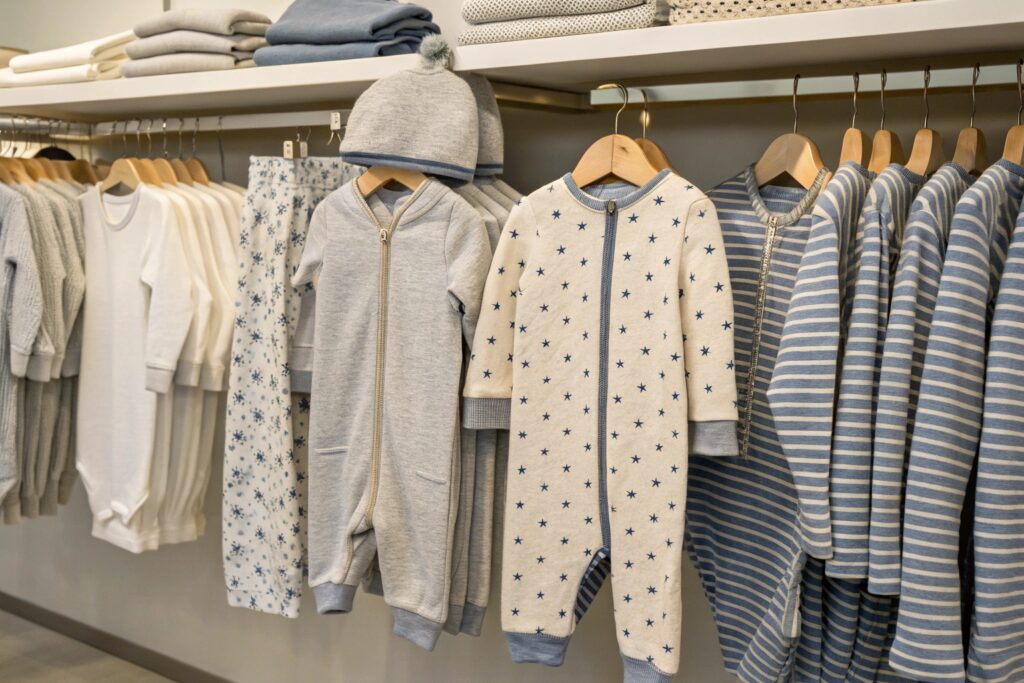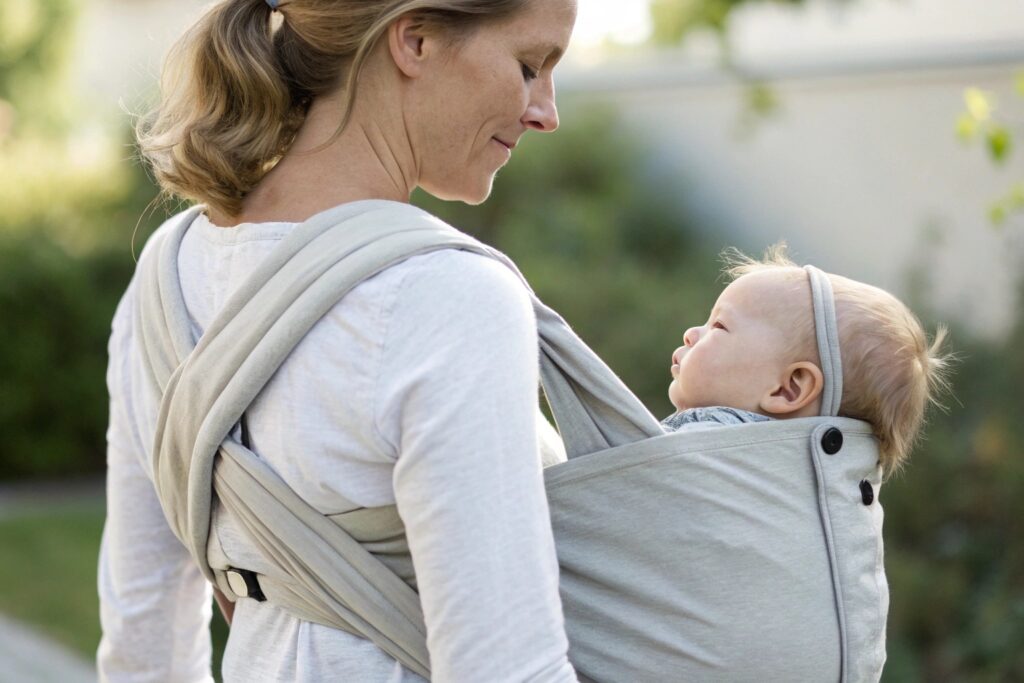Starting your first babywear collection can feel overwhelming, but it doesn’t have to be. With the right planning and insight, you can create a successful collection that resonates with both parents and retailers. As a clothing manufacturer, we understand the importance of quality, design, and functionality in babywear. Our goal is to guide you every step of the way, offering advice on how to build a collection that stands out, meets market needs, and thrives in the competitive babywear market.
When you’re ready to create your first babywear collection, it’s important to know what’s involved. Whether you’re looking for the best fabrics, the ideal sizes, or creating something that resonates with your market, we’re here to help. We offer high-quality, customizable options to match your vision.
In this article, we’ll walk through the steps to get your collection up and running. From understanding the different sizes and fabrics needed for babywear to knowing when to start purchasing and marketing, you’ll find everything you need to make informed decisions. Let’s dive into the world of babywear and learn how you can create a collection that stands out in the market.
What is a collection of first size baby clothes called?
When starting your first babywear collection, it’s important to know the terminology and sizing conventions in the industry. The collection of first-size baby clothes is typically referred to as "newborn" or "0-3 months" sizing. In some cases, brands may also use the term "first size" to describe clothing that fits babies in their earliest weeks of life. Understanding these terms is essential for correctly categorizing your products and catering to your target audience.
Understanding newborn sizing:
The newborn category is one of the most crucial size ranges in babywear, as it directly caters to infants in their first few weeks of life. Newborn-sized clothes typically fit babies who weigh up to 10 pounds. These garments are designed to be soft, gentle on the skin, and easy to put on and take off. For a successful collection, you need to focus on clothes that are not only adorable but also comfortable for the babies and practical for parents.

What does "first size" really mean for your collection?
"First size" refers to the very first stage of baby clothing, typically designed for babies between birth and about 3 months old. The specific measurements of these clothes are intended to fit newborns who weigh between 5 and 10 pounds. When designing babywear for this group, think about comfort, breathability, and ease of dressing. Materials should be soft, elastic, and machine washable, as babies’ skin is particularly sensitive.
As a clothing manufacturer, ensuring that your first-size collection is both practical and stylish is key. Parents appreciate designs that are not only comfortable but also visually appealing. Your collection should include a range of styles—from onesies and bodysuits to dresses, rompers, and accessories that can fit babies in this critical early stage of life.
How to choose the right fabrics for newborn baby clothes?
Choosing the right fabrics for newborn clothing is crucial for both comfort and functionality. Babies’ skin is much more delicate than that of adults, and they need fabrics that are gentle, breathable, and hypoallergenic. Cotton is the most popular fabric for newborn clothing due to its softness and breathability, making it the ideal material for this age group. Organic cotton is a growing trend as it offers a more sustainable, eco-friendly option that parents are increasingly looking for.
Besides cotton, fabrics like bamboo, jersey knit, and muslin are also great choices for baby clothes. These fabrics are soft to the touch, hypoallergenic, and absorbent, ensuring that the baby stays comfortable throughout the day. Consider adding these fabrics to your collection to appeal to parents who are looking for eco-conscious options.
What week to start buying baby stuff?
One of the most frequently asked questions by expectant parents is: when should I start buying baby stuff? The best time to begin purchasing baby clothing and gear is typically around the 20th to 30th week of pregnancy. This is when parents have likely completed their initial nesting phase and are ready to focus on gathering the essentials for their baby.
Planning ahead for your collection:
Just as expecting parents plan ahead, you should do the same when preparing your babywear collection. Aim to have your collection ready before the peak baby-buying seasons, which often coincide with seasonal changes and holidays. A good rule of thumb is to have your collection designed, produced, and available for sale well ahead of time. This will give you ample time to market your products and build customer interest.

Should you buy early or wait until later?
For parents, the decision of when to purchase babywear largely depends on the comfort and readiness they feel. Many choose to start buying baby clothes early to take advantage of discounts, bulk deals, or simply to avoid the stress of last-minute shopping. Similarly, when it comes to your babywear collection, it’s a smart strategy to start planning, designing, and sourcing your products well in advance. This way, you’ll be prepared to meet demand as soon as the babywearing season kicks off.
For your collection, purchasing raw materials and fabrics early on gives you time to ensure quality, meet production deadlines, and have inventory ready for early sales. You’ll also have time to iron out any production issues or delays, ensuring your collection reaches the market on time.
Benefits of starting to buy baby items early
By starting early, parents have more time to research, compare prices, and ensure they’re getting the best deals on baby products. For you, buying early can help you establish a smooth production schedule, create high-quality designs, and set competitive prices for your collection. Additionally, starting early gives you time to market your products effectively, ensuring they are seen by the right people at the right time.
Early purchasing is especially important when working with overseas suppliers, as shipping times can vary, and you may face unforeseen delays. By purchasing your fabrics and other materials ahead of time, you’ll be able to stay ahead of the curve and avoid unnecessary stress closer to launch time.
When should you start babywearing?
Babywearing is a practice that involves carrying a baby in a sling, wrap, or carrier, which can be beneficial for both parents and babies. Many parents wonder when to start babywearing, and the answer is that it can begin as soon as both the parent and the baby are ready. This typically happens within the first few weeks of life. However, it’s important to choose a baby carrier or wrap that’s comfortable and safe for both the baby and the parent.
Choosing the right babywearing items for your collection:
If your collection includes babywearing accessories, it’s essential to design carriers, slings, or wraps that prioritize safety, comfort, and ease of use. Materials like soft cotton or organic cotton are ideal for babywearing gear, as they are gentle on the baby’s skin and provide enough flexibility to accommodate the baby’s movements.

Babywearing options for your collection
When it comes to designing babywearing products, you have a variety of options to consider. Baby wraps are ideal for newborns and very young babies, as they provide a snug, close-fitting hold. On the other hand, structured carriers are better for older babies and provide extra support for both the baby and the parent. Depending on your target audience, you can design your babywearing products to cater to different preferences—whether they prefer wraps, slings, or structured carriers.
For your collection, think about offering adjustable carriers that can fit different body sizes and offer multiple carrying positions. These products can appeal to a wide range of parents looking for flexibility and comfort in their babywearing gear.
Benefits of babywearing for parents and babies
Babywearing is beneficial for both babies and parents. It fosters a strong bond between the parent and the child, helps calm the baby, and provides a sense of security. Babywearing also allows parents to stay hands-free while keeping the baby close, making it easier to get things done throughout the day.
By including babywearing accessories in your collection, you can tap into a growing market of parents who appreciate the functional, hands-free convenience that babywearing offers. A well-designed, comfortable carrier can be a valuable addition to any babywear collection.
Should you buy 0-3 months or 3-6 months?
When it comes to stocking baby clothes, one of the most common questions is whether to buy 0-3 months or 3-6 months sizes. This decision depends on the growth rate of babies and the particular needs of the parents. While the 0-3 months size is essential for newborns, the 3-6 months size is also in high demand, as babies quickly grow into it after their first few months.
Choosing the right size for your babywear collection:
For your first babywear collection, it’s essential to have a variety of sizes to cater to different stages of a baby’s early life. While the 0-3 months size is perfect for newborns, the 3-6 months size is important for parents looking to purchase clothing for their growing babies. By including both sizes in your collection, you ensure that you meet the needs of a broader market.

When should you stock 0-3 months clothes?
The 0-3 months size is critical for the early weeks of a baby’s life. This is when parents are typically focused on buying essential clothing, such as onesies, sleepers, and socks. These clothes are designed to fit newborns and infants who weigh between 5-10 pounds. For your collection, it’s important to offer a variety of these basic, essential items in soft, breathable fabrics.
When should you stock 3-6 months clothes?
The 3-6 months size is ideal for babies who are starting to grow quickly. This size category includes a wide variety of clothing, including bodysuits, rompers, and outerwear. Since babies grow fast, this size is often in high demand, as parents will need new clothes for their babies in this stage. Offering a good range of 3-6 months clothing in your collection ensures that you can meet the needs of parents at this key point in their child’s development.
Conclusion
Starting your first babywear collection is an exciting venture, and with careful planning and thoughtful design, you can create a collection that resonates with parents and retailers alike. By focusing on sizing, choosing the right fabrics, and understanding the needs of your target market, you’ll be well on your way to creating a successful collection. With our expertise and high-quality manufacturing capabilities, we’re here to help you every step of the way. Let’s create something wonderful together.










